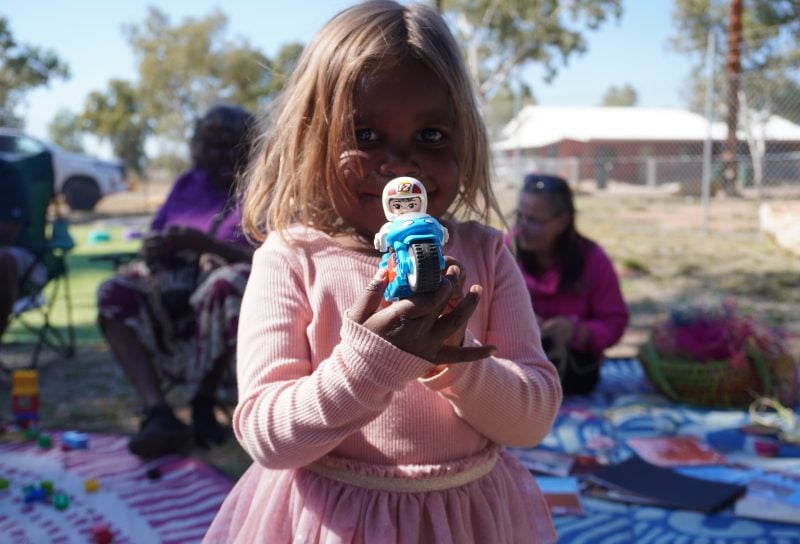
Closing the Gap Website
The official Closing the Gap website with further information on the National Agreement and relevant resources.
Visit Site
National Agreement on Closing the Gap
The current version of the National Agreement, as agreed by Joint Council.
Read the National Agreement
Coalition of Peaks on Closing the Gap
The official Coalition of Peaks website with further information on the National Agreement and the role the Coalition of Peaks plays.
Visit SiteWhat is the National Agreement on Closing the Gap?
The National Agreement on Closing the Gap is an agreement between the Coalition of Aboriginal and Torres Strait Islander Peak Organisations and all Australian governments on how governments work with Aboriginal and Torres Strait Islander peoples.
The National Agreement on Closing the Gap remains one of the strongest policy measures that SNAICC has to influence and work with all Australian Governments on improving outcomes for Aboriginal and Torres Strait Islander children and families. Through the National Agreement, all Governments have committed to four Priority Reforms that transform the way they work, and 17 socio-economic targets focused on ensuring equitable life outcomes for Aboriginal and Torres Strait Islander children, families and communities.
The National Agreement was officially formed on July 27, 2020, when the Coalition of Peaks, all Australian governments and the Australian Local Government Association signed the National Agreement on Closing the Gap. The National Agreement has been built around what Aboriginal and Torres Strait Islander peoples have said is essential for improving the lives of Aboriginal and Torres Strait Islander peoples and to change the way governments work with Aboriginal and Torres Strait Islander peoples, as well as new government accountability measures and shared monitoring and implementation arrangements. All Australian governments are working with Aboriginal and Torres Strait Islander peoples, their communities, organisations and businesses to implement the National Agreement on Closing the Gap at a national, state and territory, and local levels.
The new way of working requires governments to build on the strong foundations Aboriginal and Torres Strait Islander people have, through their deep connection to family, community and culture. Implementation Plans have been developed and delivered by each party to the National Agreement, in partnership with Aboriginal and Torres Strait Islander partners and set out how policies and programs are aligned to the National Agreement and what actions will be taken to achieve the Priority Reforms and outcomes.
Closing the Gap is underpinned by the belief that when Aboriginal and Torres Strait Islander people have a genuine say in the design and delivery of policies, programs and services that affect them, better life outcomes are achieved.
Productivity Commission’s Annual Data Compilation Report
Released on Wednesday 31 July 2024, the Annual Data Compilation Report informs reporting on progress under the National Agreement on Closing the Gap. The latest data release reveals only five of 19 Closing the Gap targets are on track.
Catherine Liddle, CEO of SNAICC, has called for governments to move quickly, saying that the involvement of Aboriginal and Torres Strait Islander people and communities in decision-making processes is crucial for improving outcomes (read our full statement here).
The Productivity Commission’s Annual Data Compilation Report is available to read online.
View the full reportThe Review of the National Agreement on Closing the Gap report
The Productivity Commission released the first of its three-yearly reviews of the National Agreement on 7 February 2024, with a strong recommendation that governments need to move out of a business as usual mindset and embrace power-sharing arrangements.
SNAICC supports the Productivity Commission’s recommendations to drive progress and improve life outcomes under the National Agreement (read our full statement here).
The Review of the National Agreement on Closing the Gap report is available to read online.
Read the full ReportThe Closing the Gap 2023 Annual Report and 2024 Implementation Plan
The Federal Government delivered the Commonwealth Closing the Gap 2023 Annual Report and 2024 Implementation Plan on 13 February 2024.
The 2023 Annual Report assesses the Commonwealth’s delivery against actions outlined in the 2023 Implementation Plan. The 2024 Implementation Plan is forward looking, outlining the Commonwealth’s strategic priorities for Closing the Gap over the next year.
The Commonwealth’s 2023 Annual Report and 2024 Implementation Plan is available to read online.
Read the full ReportOur Role in Closing the Gap
SNAICC is a founding member of the Coalition of Peaks, a collective of 80 Aboriginal and Torres Strait Islander Peak Bodies that represent over 800 Aboriginal and Torres Strait Islander community-controlled organisations across Australia.
The Coalition of Peaks plays a key role in holding governments accountable for their commitments under the National Agreement. The Coalition of Peaks is led by Aunty Pat Turner as the Lead Convener and SNAICC CEO, Catherine Liddle, is one of two Deputy Lead Conveners. The Coalition of Peaks came together as an act of self-determination to be formal partners with Australian governments on Closing the Gap.
SNAICC takes the concerns and opportunities raised by Aboriginal and Torres Strait Islander community-controlled organisations and Members on issues of early childhood education and care, child protection and family safety to national forums and advocates for policy reform. SNAICC also takes its responsibility as a member of the Coalition of Peaks seriously and contributes to working groups and shared decision-making forums on a wide range of cross-cutting structural issues including:
- workforce
- economic development and inclusion
- sovereignty
- evaluation and monitoring
- reforming the public sector.
SNAICC continues to work alongside and in partnership with peak bodies from across Australia to get the best outcomes for Aboriginal and Torres Strait Islander peoples, organisations and communities, and keep all governments accountable for their commitments under the National Agreement.
SNAICC is committed to bridging educational and opportunity gaps for Aboriginal and Torres Strait Islander children. By addressing systemic inequalities, all future generations will have access to culturally appropriate education and will not be over-represented in the child welfare system.
The Priority Reforms
The National Agreement is built around four Priority Reforms to change the way government work with Aboriginal and Torres Strait Islander communities, organisations and people to accelerate improvements in Closing the Gap.
The Priority Reforms arose from the partnership between Australian governments and the Coalition of Peaks and respond to the voices and aspirations of Aboriginal and Torres Strait Islander people.
Priority Reform One: Formal partnerships & shared decision-making
Priority Reform Two: Building the community-controlled sector
Priority Reform Three: Transforming government organisations
Priority Reform Four: Shared access to data and information at a regional level
Relevant outcome areas
Outcome 3
Aboriginal and Torres Strait Islander children are engaged in high-quality, culturally appropriate early childhood education.
Target: By 2025, increase the proportion of Aboriginal and Torres Strait Islander children enrolled in Year Before Fulltime Schooling early childhood education to 95 per cent.
Outcome 3Outcome 4
Aboriginal and Torres Strait Islander children thrive in their early years.
Target: By 2031, increase the proportion of Aboriginal and Torres Strait Islander children assessed as developmentally on track in all five domains of the Australian Early Development Census to 55 per cent.
Outcome 4Outcome 11
Aboriginal and Torres Strait Islander young people are not over-represented in the criminal justice system.
Target: By 2031, reduce the rate of Aboriginal and Torres Strait islander young people (10–17 years) in detention by at least 30 per cent.
Outcome 11Outcome 12
Aboriginal and Torres Strait Islander children are not over-represented in the child protection system.
Target: By 2031, reduce the rate of over-representation of Aboriginal and Torres Strait Islander children in out-of-home care by 45 per cent.
Outcome 12Outcome 13
Aboriginal and Torres Strait Islander families and households are safe.
Target: By 2031, the rate of all forms of family violence and abuse against Aboriginal and Torres Strait Islander women and children is reduced at least by 50%, as progress towards zero.
Outcome 13Background on the National Agreement on Closing the Gap
The original Closing the Gap policy was agreed upon in 2008 as a positive step forward in a nationally coordinated effort to improve the lives of Aboriginal and Torres Strait Islander people. However, progress was slow and many Aboriginal and Torres Strait Islander people and organisations were excluded from policy priorities and actions.
In 2016, the Australian government wanted to update the Closing the Gap strategy. SNAICC was one of the original 14 organisations concerned that governments would make decisions about us, without us. Consequently, the Coalition of Peaks was formed to collaborate with governments on a new approach to Closing the Gap. It took a lot of discussion and work, but the National Partnership Agreement on Closing the Gap was born.
Under the Partnership Agreement, the Coalition of Peaks met with Australian governments to assess what had and hadn’t worked on Closing the Gap over the previous ten years, what could be strengthened and what needed to be changed. The Coalition of Peaks and Governments agreed that the National Indigenous Reform Agreement – an agreement signed by Australian governments in 2008 that set out the original Closing the Gap strategy – needed to be replaced by a new National Agreement built around what Aboriginal and Torres Strait Islander people have said is needed to improve our lives; and to be signed off by the Coalition of Peaks and Governments.
In late 2019, the Coalition of Peaks led a comprehensive engagement process that informed the National Agreement. Aboriginal and Torres Strait Islander people from across Australia were consulted to determine what should be included. The Joint Council met on July 3, 2020, to discuss the final draft of the National Agreement on Closing the Gap. It is the first National Agreement of its kind, developed in true collaboration between the Coalition of Peaks and the Australian Governments.
The National Agreement lays out a strategy for closing the gap that is heavily based on and supported by the priorities of Aboriginal and Torres Strait Islander peoples.
Resources
Join Us
Be part of our advocacy efforts and stay informed about our initiatives.
Become a member today and add your voice to the cause.




